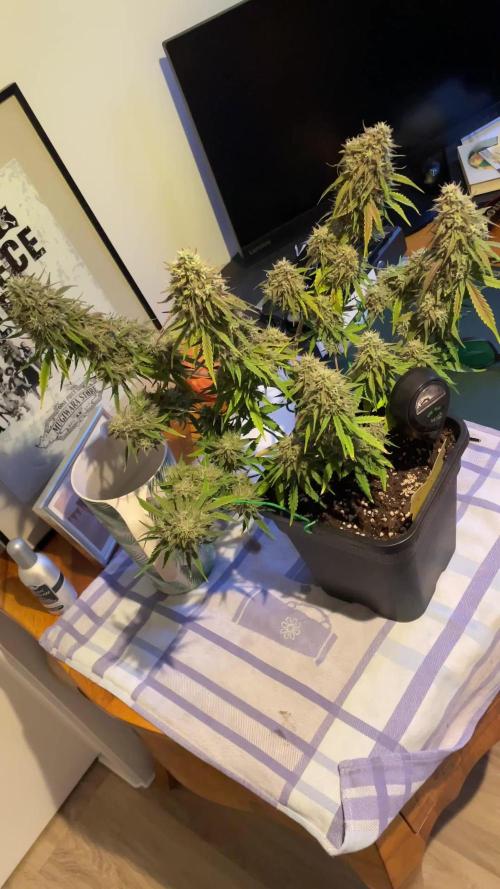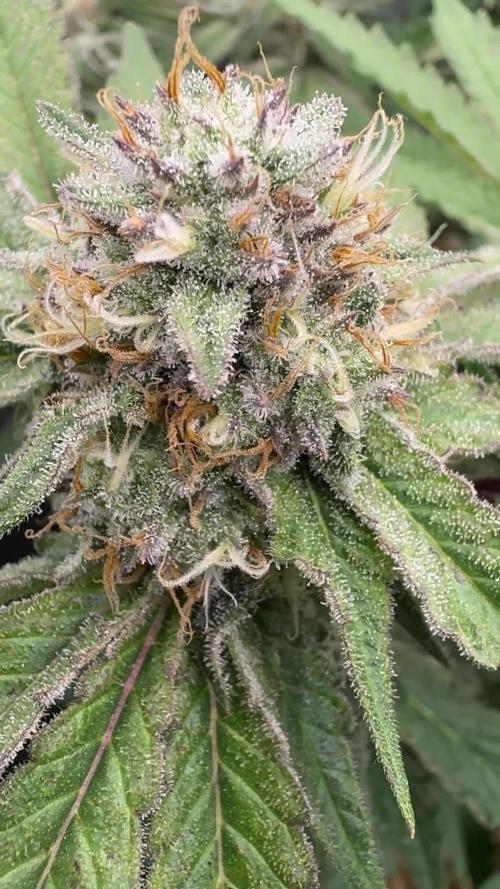The Grow Awards 2026 🏆 



































Likes
2
Share


@smoking_hills9
Follow
Fantastic grow. Very happy with all 3 strains, all just perfect. Super stinky, very frosty, and as always tones of buds . Now time to cut and dry.
Likes
13
Share


@DonKrika
Follow
Similar conditions as last week, but the plant is getting bigger, so is drinking more, I was finally able to feed the plant 2 times in one week.
This week I also introduced a foliar spray. I applied the foliar spray 1h after the lights turned off, next time I need to give it a bit earlier, right after the lights turn off.
I also used Mycorrhizae this week as well
I feel that the initial problems that I had been solved, the plant is growing at a normal pace now.
DAY 30 - Water
PH - 5.80
PPM- 531
Solution Temp - 22
Watering Volume - 2L
DAY 33 - Nutes
PH - 6.02
PPM- 1600
Solution Temp - 21
Watering Volume - 1.2L
Foliar Spray
PH - 5.21
PPM- 1450
Solution Temp - 21
Watering Volume - 100 ml
Likes
2
Share


@Mondolibero
Follow
Settima settimana quasi le piante sono state travasate tutte peccato per una perché nn avevo più vasi grandi e lo dovuta mettere in un vaso da 3L. Tutte sono state toppate altre spezzate e abbassate per promuovere i rami interni in modo da avere più schermo verde possibile tra un paio forse anche meso due settimane vorrei swicciare 12/12 vedremo.....per il momento le piante hanno reagito bene al travaso solo una mi sta dando qualche piccolo problema con la fertilizzazione, staremo a vedere.
Likes
5
Share


@GermGrowFox
Follow
3. November
Alle drei Pflanzen weiterhin topfit.
Trauermücken aufgetreten. Habe das abgelaufene Päckchen nematoden für die runtz genutzt. Hoffe es bringt was
4. November
Cookies Gelato hat den harten Mainlinecut bekommen. Spitze wurde entfernt, Seitenteile wurden direkt danach abgeschnitten. Sie wird’s schon wegstecken.
Tropimango und runtz geht’s gut :)
Cookie gelato hat bereits wenige Stunden später die Blätter wieder hoch gestreckt. Stagniert.
5. November
Alles gut. Die Schnitte wurden gut verkraftet. Triebe wachsen wieder
Cookies gelato ist nun 21 Tage alt.
Tropimango ist nun 18 Tage alt.
Runtz ist nun 7 Tage Alt.
7. November
Cookies gelato wächst. Sobald die Klammern da sind wird sie runtergebunden
Tropimango hat schnitte und Lst bekommen. Topping werde ich noch abwarten.
Runtz wächst
8. November
Cookies gelato hat LST + mainlineschnitte erhalten. Wurde nicht mit gießen kombiniert da ich gestern gegossen habe.
Tropimango erneut LST.
Runtz wächst. Sieht aus als würde sie langsam ins Wachstum wechseln. Erster Triebe am einzahnblatt kommen. Dreizahnblatt erst frisch entwickelt.
9. November
Cookies gelato wurde das erste mal zusätzlich mit Sugar Royal und calmag versorgt. Hab’s davor vergessen 😅 Shit Happens.
Wurzeldünger gibt es konstant weiter.
Runtz wurde mit wurzeldünger und calmag versorgt
Tropimango hat noch sehr feuchte Erde. Keine Ahnung wieso.
Likes
18
Share


@Hawkbo
Follow
Did a full leaf strip on everything this week, the pics and videos were taken 2 days ago I just havnt got around to uploading them. Everything bounced right back after the strip but the pots arent drying out as fast and humidity went down a little bit.
Use the code bangdang for 10% the following sponsors..
@greenbuzzliquids
@rainscience_growbags
@gorilla_grow_tent
@growlightscience.led
Processing
Likes
16
Share


@Joehydro
Follow
Finally starting to smell that heavenly smell and seeing budlets exploding everywhere. Both girls were defoliated a little at a time over the past week to expose any prime bud sites. So far both strains have been lovely and easy to grow as long as Nutes are fairly light. Will keep updates through the week and as always happy growing everyone!😊🤙
Likes
11
Share


@Bud_vista
Follow
We entered week 10 now.
She will need about one more week until I will chop her :)
Until now, everything went fine and she’s smelling fantastic. I’m in love with this plant, she’s just beaut
Likes
5
Share


@Jayndre69
Follow
Well flush them out for a week and then chop chop. Very happy tho was hoping for some more colours.
Likes
3
Share


@tony_kiffton
Follow
Es ist ist richtig kalt in der Garage ... die oberen Blätter sind immer noch hell - für mich aber kein kein unnötig zu düngen - die Aufnahme ist durch die niedrigen Temperaturen einfach nur gehemmt.
Processing
Likes
20
Share


@Tikihoofd
Follow
After the repotting at the end of week 4, I watered my plants for a couple of days only using water (day 31 - 34).
On day 34 I added some small LST cords, and watered.
On day 35 I switched my lighting schedule from veg. to flowering, and watered.
On day 36 I watered with nutrients.
On day 37 I watered.
On day 38 I defoliated and watered with nutrients.
(The amount of nutrition used this week is combined at the top for the 3 plants.)
During defoliation, I cut the inside looking leaves, and the big overhanging sugar leaves. Here and there I also cut some new growth on the inside of the canopy because it wasn't getting enough light.
I noticed a very small amount of leaves which was yellowing on the bottom of the plant and cut them aswell. These we're from when the plant was just growing.
All in all, things are looking good. Still searching for a solution for the trellis, because the things I came up with weren't cutting it. Probably going to fix one from PVC-piping.
See ya!
Likes
11
Share


@Mo_Powers
Follow
the weather in germany is still totally changeable. temperatures from 10 degrees at night to 30 degrees during the day. and lots of rain. she is doing really well and you can see that she is made for this weather. 💪😃 i stopped LST and let it grow as it likes.
Likes
8
Share


@HakunaMatata
Follow
Posting this week so late. I dont know why i never ended this diary, but yeah... here it is :)
BSF Gorilla Glue comes with tovely buds, gave a great yield for a beginner, and a very pleasant smoke at the end.
Likes
12
Share


@Terpyboyz
Follow
Hello Fellow Growers ✌️🏻🍁
Not posted in the last week or so,
The girls have been potted up into 18litre pots using Bio all mix.
Few of them had low PPM 350/400s & some in 700s just before reporting which is low and showing N deficiency’s
So once potted up I just give them a nutrient feed of bio grow.
Since the soil is got nutrients in it am hoping this will sort it’s self out nutrient wise over the next week.
Ripper seeds - dosido x purple punch - has got some mad deficiency I can’t keep happy always looks over watered
Aiming to start flowering within the next week or so - since potting up the others I soon realised I was running out of space so I decided to chop a couple strains out.
Thought of adding a humidifier into the mix but not sure as I was having over feeding issues - anyones thoughts on this?
All auto flowering strains are starting to really get into flowering now.
Pink runtz auto - has a lovely strawberries smell.
Gorilla glue auto - isn’t looking to great, she’s got a slight deficiency.
Blue cheese auto - is growing slow I’m sure this got over fed and just hadn’t bounced back yet.
Amnesia haze auto - this is the tallest of them all she’s starting to pack on too.
Any questions or if you see anything you notice off give me a message always down for some helpful tips.
Peace 🙏🏻🍁
Likes
4
Share


@Bvercuiel
Follow
Tallest Auto I’ve ever grown. Not the fattest buds bud, but overal good grow
Likes
7
Share


@eldruida_lamota
Follow
Venga familia que acabamos la quinta semana de estás Gelato Olandese de Dutchfem.
Entramos en la recta final esta próxima semana aplicamos el PK de Agrobeta, ExplotaCogollos.
Iremos viendo el proceso de engorde de las flores.
Se ve que tienen un buen color están bien sanas, se ve que progresan adecuadamente.
Agrobeta:
https://www.agrobeta.com/agrobetatiendaonline/36-abonos-canamo
Mars hydro:
Code discount: EL420
https://www.mars-hydro.com/
Las maximas de temperatura no superan los 26 grados y las mínimas no bajan 20, así que no me puedo quejar.
Los niveles de humedad también son los correctos van entre 50%/65% de humedad relativa.
Por supuesto el Ph lo estamos dejando alrededor de 6.
Hasta aquí es todo, buenos humos 💨💨💨.
Likes
2
Share


@DrKushlife
Follow
Yaaay week 2 is finally here!!! I hope everyone is happy and well
So not much changed since last week except I have misted the leafs with regular PHd water
I have also put 2 companion chilli plants in with the gorilla now to detour any pests that might visit
I've now upped her watering amount to 500 ml per feed every 3 days
I've also now stopped using formulex
Every few days I mist the leafs with regular water
Well that's the end of week 2 in the veg phase.. See you all in week 3.. Happy growing 💪😎🙏
Likes
12
Share


@cherokee
Follow
На етой неделе я сделал ошибку, растение стояло без воды 3 дня. Автоцветы получили стрес, листья начали желтеть и показывать пятна на листьях. Надеюсь не много потеряю в качестве урожая из за этой ошибки.
Likes
3
Share


@JunoCheesecake
Follow
This week the Jack Herer has exploded.
The branches have become dense, swollen buds with lots of pistils that are turning orange.
The smell has become much more intense and citrusy, however, I think it is further along that it should be.
So far this seedling is growing nicely. I hope it continues like this






















